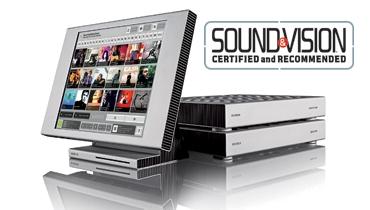Sooloos music storage and server system

The Short Form |
| $11,600 / SOOLOOS.COM / 866-606-0333 |
Snapshot |
| Audiophile-level build quality and a terrific user interface let this server do much more than just manage a music collection |
Plus |
| • High-end look and build quality • Simple yet powerful touchpanel interface • Easily handles even the largest music collections • Stellar sound |
Minus |
| • No IR control • Pricey |
Key Features |
| • Advanced interface easily tames even the largest music collections • Remote backup and location synchronization for protecting your music library and for sharing it in multiple locations • Twinstore 1-terabyte drives redundantly store up to 2,400 CDs in both lossless FLAC and 192-kbps MP3 • Additional Twinstores can be used to increase storage capacity • Focus and Swimming modes provide sophisticated ways to find and enjoy your music • Source:One single-source output ($4,000); 17 x 2 3?4 x 14 1?2 in, 12 3?4 lb • Control:One 17-inch touchpanel controller ($4,400); 18 x 13 1?2 x 7 1?4 in, 23 1?2 lb • Twinstore mirrored 1-terabyte drives for automatic library backup ($3,200), 17 x 2 3?4 x 14 1?2 in, 12 3?4 lb |
Once thought to be niche products, digital music players have become nearly ubiquitous. Between iPods, computers, and smart phones - not to mention A/V receivers, gaming systems, and even TVs - you've probably got a number of devices at home that can stream and play digital music. And while these devices can do a serviceable job of sorting and playing music files, chances are you're looking for a richer, more elegant solution. For the well heeled, there are a few servers that fit the bill, like those from Kaleidescape, ReQuest, and Qsonix.
But a new contender has entered the high-end server arena. Two years ago, I discovered Sooloos tucked away in a small downstairs area at the CEDIA Expo in Denver and was instantly enamored. The company's founders have music-industry backgrounds, and Sooloos was borne from the need to manage their massive music collections. They also wanted the experience to be fun, social, and lightning-fast. After 2 years of waiting, a system finally arrived.
SETUP
Unpacking the 70-pound box containing Sooloos's Source:One, Store:One, and Control:One components, I was struck by the system's build quality and appearance. With their machined-aluminum chassis and elegantly understated front panels, these components exude high-end panache.
The second thing I noticed was the lack of a user's manual. Upon requesting one, I learned there isn't a manual. While you could argue that the system is so easy to use that a manual is superfluous, I'd counter that the Sooloos is also a luxury product not unlike a 7-Series BMW or a hyper-expensive timepiece, and that it should include documentation that befits such a purchase.
Installation was simplicity itself. The Store:One and Control:One have only power and Ethernet connections, while the Source:One features a four-port Network switch, along with analog and coaxial digital-audio outputs, both simultaneously active. For house-wide systems where multiple streams are needed, Sooloos offers the Source: Five ($5,000), which is identical to the One but has five analog outputs. Ethernet connections can either be made directly to the Source or to a standard network switch or router.
While my review system featured the Store:One, Sooloos has since phased out that component in favor of the Twinstore, which has an identical form factor but contains a mirrored 1-terabyte hard drive to automatically back up your music library in case of drive failure.
After the components power up and discover one another, the Home menu appears on the Control:One's screen with selections for Music, Settings, Information, and Shutdown. Selecting Music takes you to your stored music library. Going to Settings reveals options like adjusting cross-fade time between tracks (from Off to 10 seconds), browsing preferences, and volume leveling. And Information displays the number of albums and tracks currently in the library, as well as the available drive space. A slot-loaded CD drive for importing music is tucked discreetly into the Control:One touchpanel's base. Putting it there was a great idea. Since you'll be constantly accessing the touchpanel, it's the perfect place for importing music, especially if the system's other components are hidden in an equipment room. Brilliant, Sooloos!
CDs took 8 to 11 minutes to import with the tracks ripped simultaneously in FLAC format and in 192-kbps MP3 for transfer to portable players. While FLAC's lossless compression saves drive space, a system this expensive really should also offer an "audiophile option" to import in WAV format as well as in higher-rez MP3. (You can also import previously ripped songs from computers on the network as long as they're in the FLAC or MP3 format.)
There's also no remote control, because the system has no IR capability, period. Sooloos does provide a Crestron interface, plus the Conrol:One panel can run Crestron X-Panel projects - a huge added benefit for Crestron owners, because using the Sooloos basically gives you a free 17-inch house-wide touchscreen controller. For the rest of us, Sooloos has an application called
Control:PC so that you can control the system using a computer hooked into the same network as the system's components. While this is nowhere near as elegant as the panel interface, it will let you queue up and change music. Also, iPhone and iTouch users can control the system, thanks to Wi-Fi.





























































